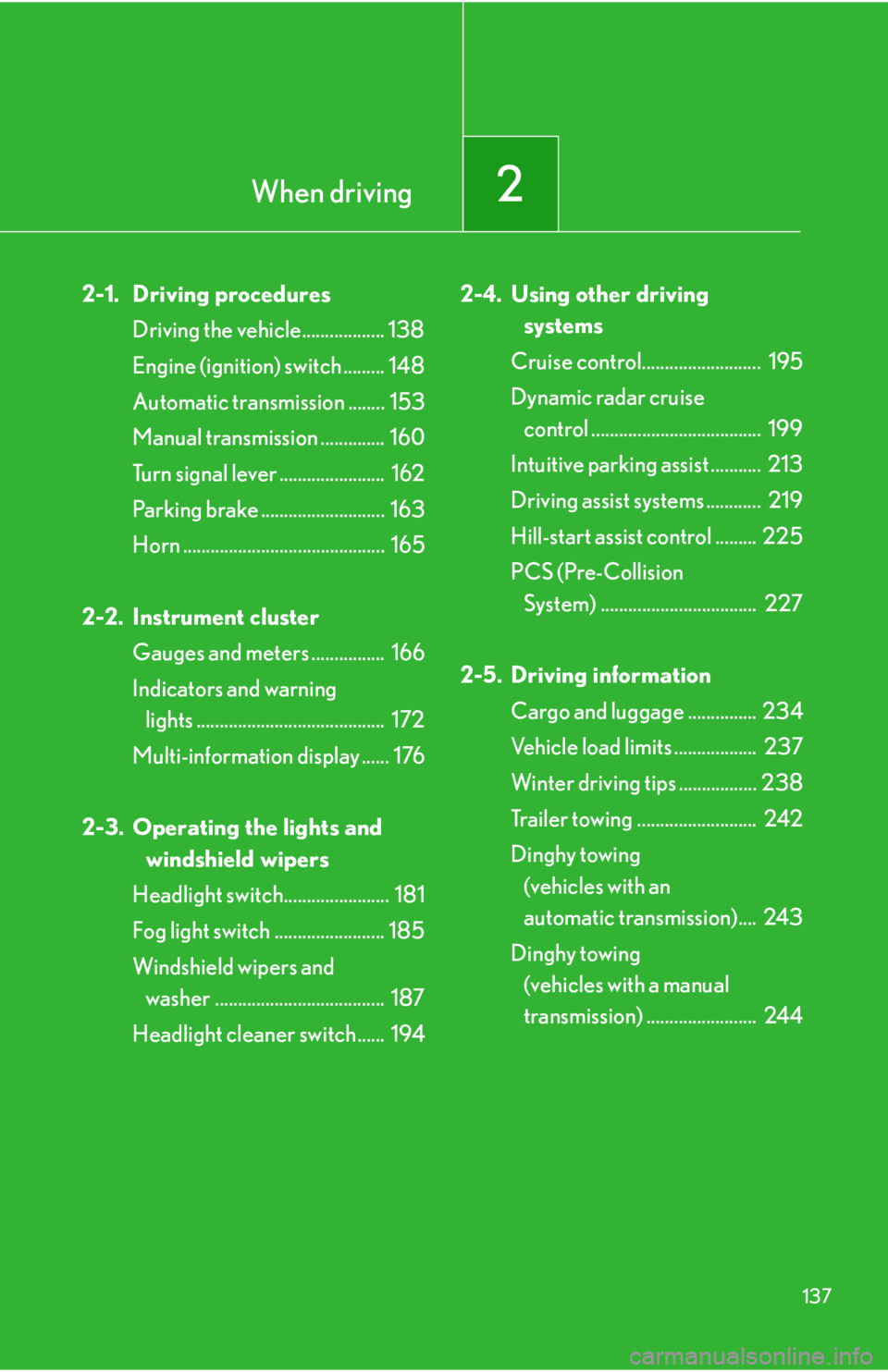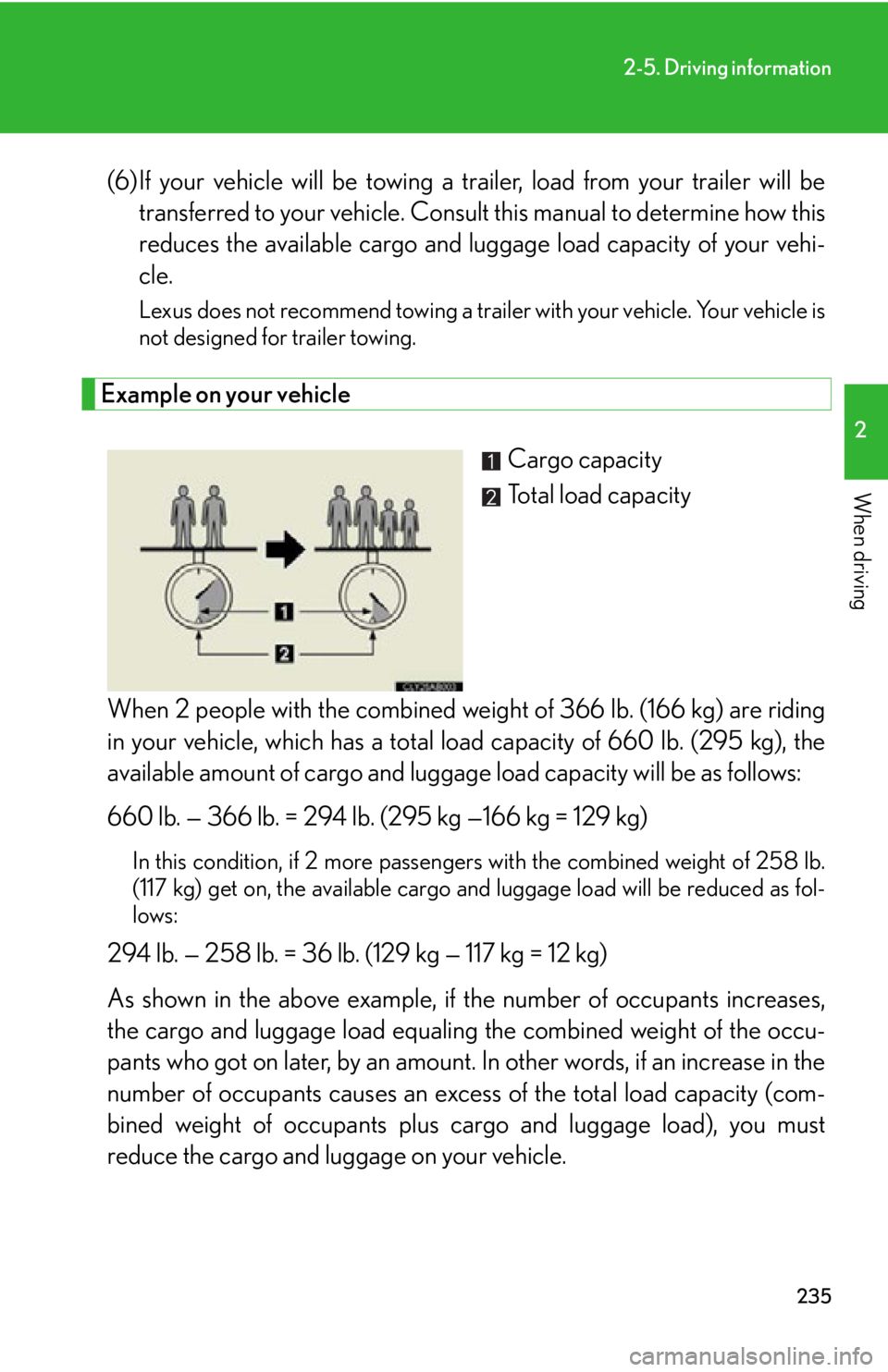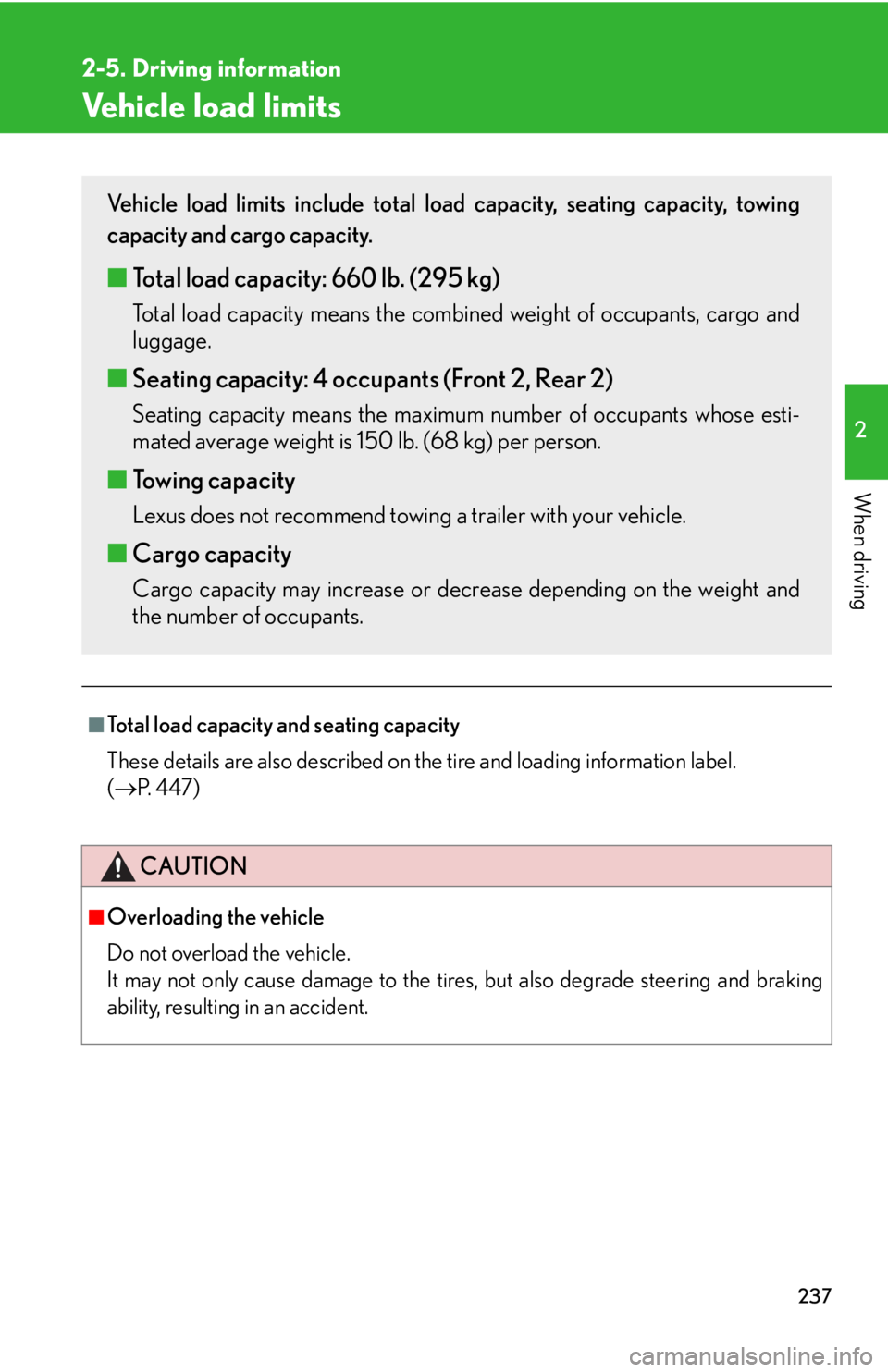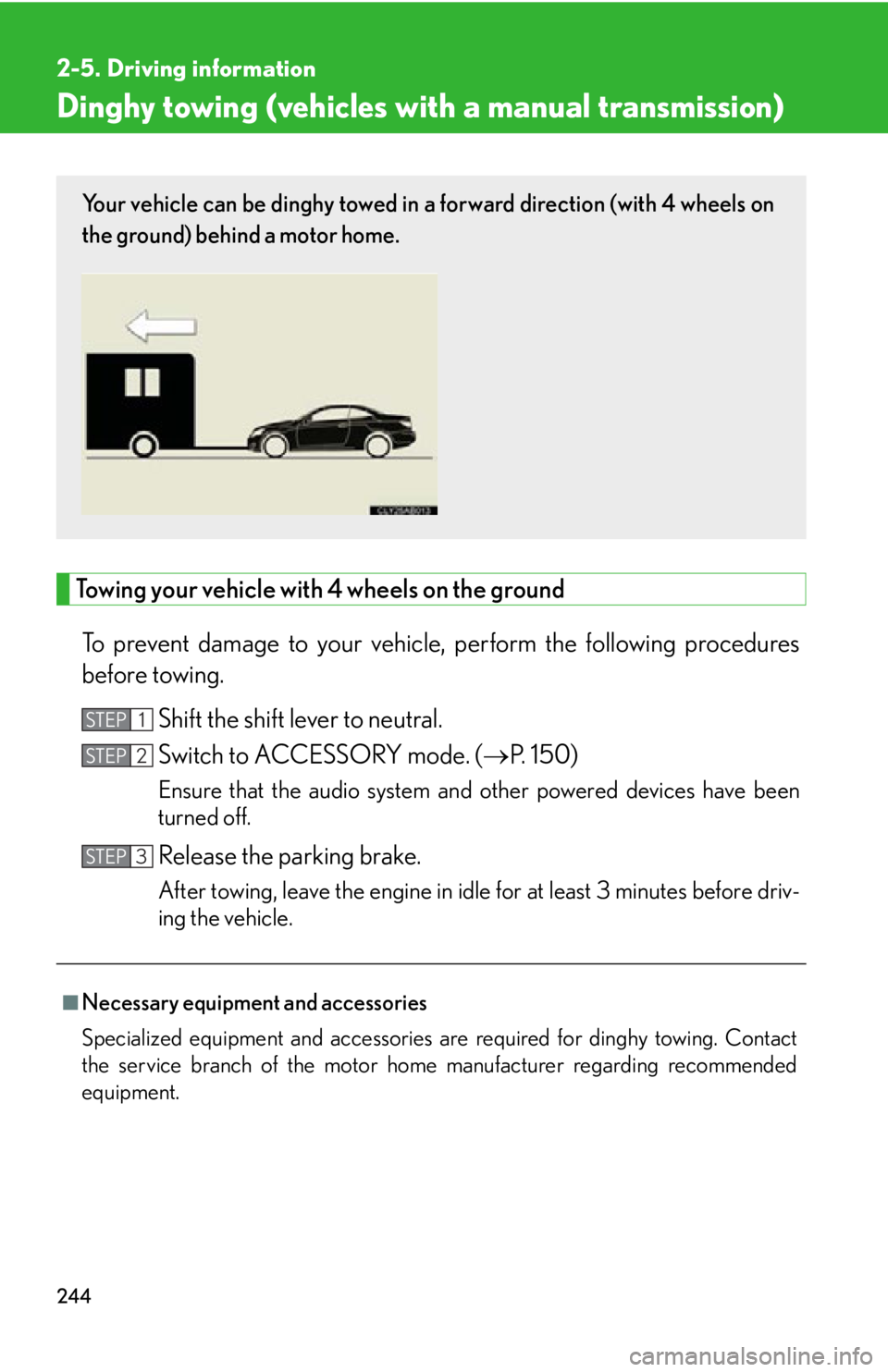towing Lexus IS250C 2012 Instrument cluster / LEXUS 2012 IS250C,IS350C OWNERS MANUAL (OM53A62U)
[x] Cancel search | Manufacturer: LEXUS, Model Year: 2012, Model line: IS250C, Model: Lexus IS250C 2012Pages: 632, PDF Size: 6.77 MB
Page 3 of 632

1
2
3
4
5
6
7
3
2-1. Driving proceduresDriving the vehicle ........................ 138
Engine (ignition) switch .............. 148
Automatic transmission.............. 153
Manual transmission .................... 160
Turn signal lever ............................ 162
Parking brake ................................. 163
Horn.................................................... 165
2-2. Instrument cluster Gauges and meters ..................... 166
Indicators and warning lights.................................................. 172
Multi-information display........... 176
2-3. Operating the lights and windshield wipers
Headlight switch ............................. 181
Fog light switch .............................. 185
Windshield wipers and washer............................................. 187
Headlight cleaner switch ........... 194 2-4. Using other driving systems
Cruise control ................................ 195
Dynamic radar cruise control............................................. 199
Intuitive parking assist ................. 213
Driving assist systems.................. 219
Hill-start assist control ............... 225
PCS (Pre-Collision System).... 227
2-5. Driving information Cargo and luggage ..................... 234
Vehicle load limits ........................ 237
Winter driving tips ....................... 238
Trailer towing ................................. 242
Dinghy towing (vehicles with an automatic
transmission) ............................... 243
Dinghy towing (vehicles with a manual
transmission) ............................... 244
2When driving
Page 137 of 632

When driving2
137
2-1. Driving proceduresDriving the vehicle.................. 138
Engine (ignition) switch ......... 148
Automatic transmission ........ 153
Manual transmission .............. 160
Turn signal lever ....................... 162
Parking brake ........................... 163
Horn ............................................ 165
2-2. Instrument cluster Gauges and meters ................ 166
Indicators and warning lights ......................................... 172
Multi-information display ...... 176
2-3. Operating the lights and windshield wipers
Headlight switch....................... 181
Fog light switch ........................ 185
Windshield wipers and washer ..................................... 187
Headlight cleaner switch...... 194 2-4. Using other driving
systems
Cruise control.......................... 195
Dynamic radar cruise control ..................................... 199
Intuitive parking assist ........... 213
Driving assist systems ............ 219
Hill-start assist control ......... 225
PCS (Pre-Collision System) .................................. 227
2-5. Driving information Cargo and luggage ............... 234
Vehicle load limits .................. 237
Winter driving tips ................. 238
Trailer towing .......................... 242
Dinghy towing (vehicles with an
automatic transmission).... 243
Dinghy towing (vehicles with a manual
transmission) ........................ 244
Page 198 of 632

198
2-4. Using other driving systems
CAUTION
■To avoid operating the cruise control by mistake
Switch the cruise control off using the “ON-OFF” button when not in use.
■Situations unsuitable for cruise control
Do not use cruise control in any of the following situations.
Doing so may result in loss of control and could cause an accident resulting in death
or serious injury.
●In heavy traffic
●On roads with sharp bends
●On winding roads
●On slippery roads, such as thos e covered with rain, ice or snow
●On steep hills
Vehicle speed may exceed the set speed when driving down a steep hill.
●During emergency towing
Page 211 of 632

211
2-4. Using other driving systems
2
When driving
CAUTION
■To avoid inadvertent cruise control activation
Switch the cruise control off using the “ON-OFF” button when not in use.
■Situations unsuitable for dynamic radar cruise control
Do not use dynamic radar cruise contro l in any of the following situations.
Doing so may result in inappropriate sp eed control and could cause an accident
resulting in death or serious injury.
●In heavy traffic
●On roads with sharp bends
●On winding roads
●On slippery roads, such as thos e covered with rain, ice or snow
●On steep downhills, or where there are sudden changes between sharp up and
down gradients
Vehicle speed may exceed the set speed when driving down a steep hill.
●At entrances to expressways
●When weather conditions are bad enough that they may prevent the sensors
from functioning correctly (fog, sn ow, sandstorm, heavy rain, etc.)
●When an approach warning buzzer is heard often
●During emergency towing
■When the sensor may not be correctly detecting the vehicle ahead
Apply the brakes as necessary when any of the following types of vehicles are in
front of you.
As the sensor may not be able to correctly detect these types of vehicles, the
approach warning (P. 205) will not be activated, and a fatal or serious accident
may result.
●Vehicles that cut in suddenly
●Vehicles traveling at low speeds
●Vehicles that are not moving
●Vehicles with small rear ends (tra ilers with no load on board etc.)
●Motorcycles traveling in the same lane
Page 217 of 632

217
2-4. Using other driving systems
2
When driving
■Sensor detection information
●Certain vehicle conditions and the surrounding environment may affect the
ability of the sensor to correctly detect obstacles. Particular instances where this
may occur are listed below.
• There is dirt, snow or ice on the sensor.
• The sensor is frozen.
• The sensor is covered in any way.
• The vehicle is leaning considerably to one side.
• On an extremely bumpy road, on an incline, on gravel, or on grass.
• The vicinity of the vehicle is noisy due to vehicle horns, motorcycle engines,
air brakes of large vehicles, or other loud noises producing ultrasonic waves.
• There is another vehicle equipped with parking assist sensors in the vicinity.
• The sensor is coated with a sheet of spray or heavy rain.
• The vehicle is equipped with a fender pole or wireless antenna.
• Towing eyelets are installed.
• The bumper or sensor receives a strong impact.
• The vehicle is approaching a tall or curved curb.
• In harsh sunlight or intense cold weather
In addition to the examples above, there are instances in which, because of their
shapes, signs and other object s may be judged by the sensor to be closer than they
are.
●The shape of the obstacle may prevent th e sensor from detecting it. Pay particu-
lar attention to the following obstacles.
• Wires, fences, ropes etc.
• Cotton, snow and other materials that absorb radio waves
• Sharply-angled objects
•Low obstacles
• Tall obstacles with upper sections projec ting outwards in the direction of your
vehicle
■When the display flashes and a message is displayed
P. 5 0 4
Page 235 of 632

235
2-5. Driving information
2
When driving
(6)If your vehicle will be towing a trailer, load from your trailer will betransferred to your vehicle. Consul t this manual to determine how this
reduces the available cargo and luggage load capacity of your vehi-
cle.
Lexus does not recommend towing a trailer with your vehicle. Your vehicle is
not designed for trailer towing.
Example on your vehicle
Cargo capacity
Total load capacity
When 2 people with the combined weight of 366 lb. (166 kg) are riding
in your vehicle, which has a total load capacity of 660 lb. (295 kg), the
available amount of cargo and luggag e load capacity will be as follows:
660 lb. — 366 lb. = 294 lb. (295 kg —166 kg = 129 kg)
In this condition, if 2 more passengers with the combined weight of 258 lb.
(117 kg) get on, the available cargo and luggage load will be reduced as fol-
lows:
294 lb. — 258 lb. = 36 lb. (129 kg — 117 kg = 12 kg)
As shown in the above example, if the number of occupants increases,
the cargo and luggage load equaling the combined weight of the occu-
pants who got on later, by an amount. In other words, if an increase in the
number of occupants causes an excess of the total load capacity (com-
bined weight of occupants plus cargo and luggage load), you must
reduce the cargo and luggage on your vehicle.
Page 237 of 632

237
2-5. Driving information
2
When driving
Vehicle load limits
■Total load capacity and seating capacity
These details are also described on the tire and loading information label.
( P. 4 4 7 )
CAUTION
■Overloading the vehicle
Do not overload the vehicle.
It may not only cause damage to the tire s, but also degrade steering and braking
ability, resulting in an accident.
Vehicle load limits include total lo ad capacity, seating capacity, towing
capacity and cargo capacity.
■ Total load capacity: 660 lb. (295 kg)
Total load capacity means the combined weight of occupants, cargo and
luggage.
■ Seating capacity: 4 occupants (Front 2, Rear 2)
Seating capacity means the maximum number of occupants whose esti-
mated average weight is 150 lb. (68 kg) per person.
■Towing capacity
Lexus does not recommend towing a trailer with your vehicle.
■Cargo capacity
Cargo capacity may increase or decrease depending on the weight and
the number of occupants.
Page 242 of 632

242
2-5. Driving information
Trailer towing
Lexus does not recommend towing a trailer with your vehicle. Lexus also
does not recommend the installation of a tow hitch or the use of a tow hitch
carrier for a wheelchair, scooter, bicycle, etc. Your Lexus is not designed
for trailer towing or for the us e of tow hitch mounted carriers.
Page 243 of 632

243
2-5. Driving information
2
When driving
Dinghy towing (vehicles with an automatic transmission)
NOTICE
■To avoid serious damage to your vehicle
Do not tow your vehicle with four wheels on the ground.
Your vehicle is not designed to be dinghy towed (with 4 wheels on the
ground) behind a motor home.
Page 244 of 632

244
2-5. Driving information
Dinghy towing (vehicles with a manual transmission)
Towing your vehicle with 4 wheels on the groundTo prevent damage to your vehicle, perform the following procedures
before towing. Shift the shift lever to neutral.
Switch to ACCESSORY mode. ( P. 150)
Ensure that the audio system and other powered devices have been
turned off.
Release the parking brake.
After towing, leave the engine in idle for at least 3 minutes before driv-
ing the vehicle.
■Necessary equipment and accessories
Specialized equipment and accessories are required for dinghy towing. Contact
the service branch of the motor home manufacturer regarding recommended
equipment.
Your vehicle can be dinghy towed in a forward direction (with 4 wheels on
the ground) behind a motor home.
STEP1
STEP2
STEP3